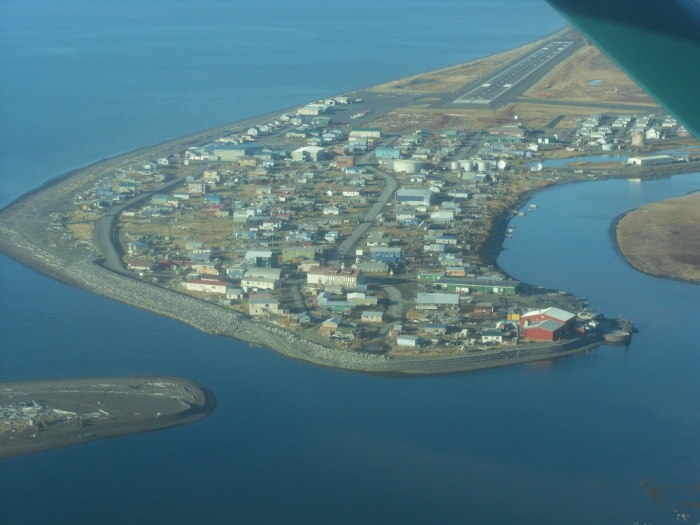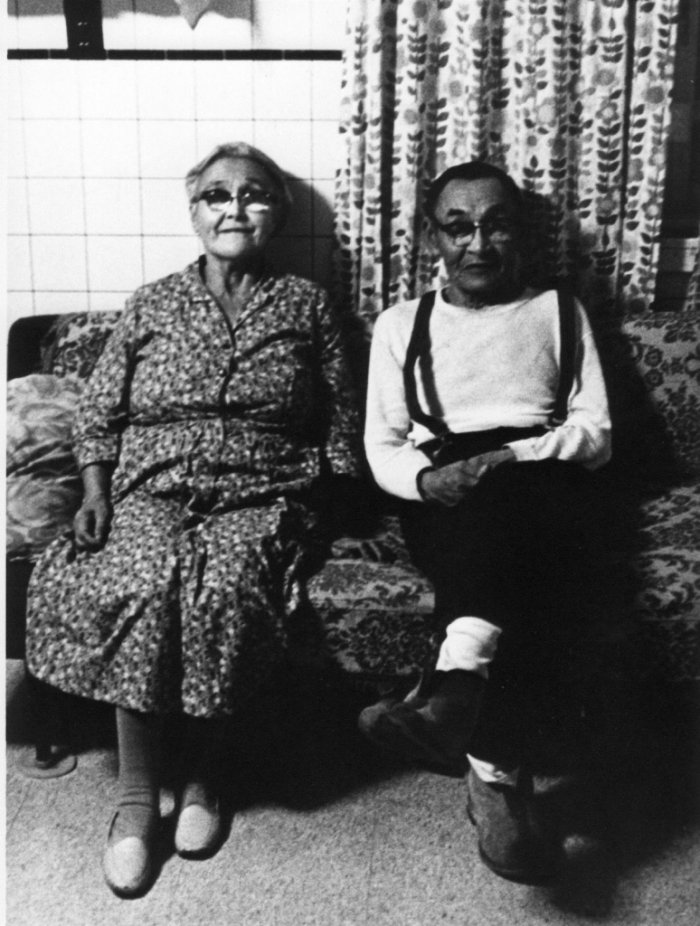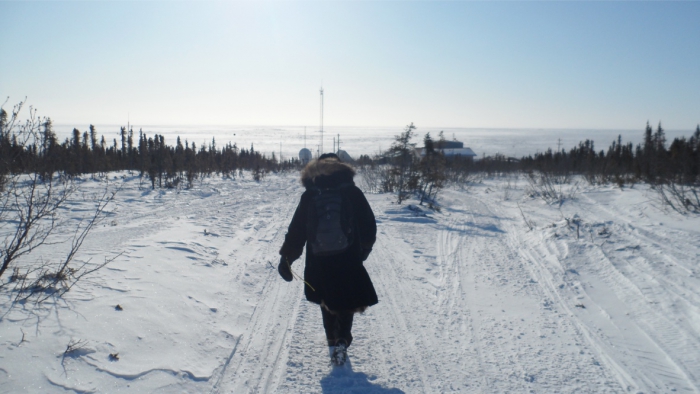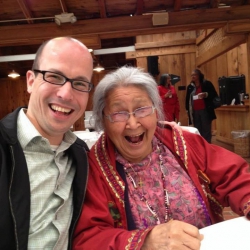By: Jordan P. Lewis, Associate Professor (WWAMI) School of Medical Education; Director, National Resource Center for Alaska Native Elders; University of Alaska Anchorage, College of Health
Alaska Native communities have a strong sense of respect for their older residents. In many Alaskan rural communities, whose primary population is Alaska Native people, the elderly are still relied upon for their deep knowledge and understanding of the natural environment, heritage languages, and cultural practices that are important not only for economic survival but social cohesion and community wellbeing. However, change is deeply affecting Alaska Native communities and Alaska Native people are forced to adapt to the new environmental, economic, and social realities that affect their worlds. A research project entitled "Investigating the Health and Wellbeing of Alaska Native Elderly in Northwest Alaska through Community Participatory Based Research Methods," led by Jordan Lewis and funded by the National Science Foundation (NSF) Office of Polar Programs, Arctic Social Sciences, investigates how Alaska Native Elders are adapting to rapid economic, environmental, and social change by exploring their own understanding and definition of what successful aging means to them. The goal of the research project is to establish a better understanding of successful aging from the perspectives of Alaska Native elderly in Anchorage, the Northwest, and Aleutian Island regions of Alaska.
Jordan Lewis (Aleut, Native Village of Naknek, Alaska) previously conducted his dissertation study "Successful Aging through the Eyes of Alaska Native Elders: What it Means to be an Elder in Bristol Bay, AK" from 2007–2009, which was also funded by NSF Arctic Social Sciences Program. This study brought awareness of the value of positive, or strengths-based, research with Elders to gain a deeper understanding of the skills, strengths, and characteristics that enable them to age well—and how those strengths can be shared with others in the community to support healthy aging for all generations. In this research, the term "Elder" differentiates Indigenous Elders of Alaska from those who are considered older adults. Community respect for Elders is a cultural convention that distinguishes those Elders who have lived traditionally, who continue to serve as an integral part of their community, and are viewed as role models (Lewis, 2010, 2011). To shift the focus from western concepts of aging that uses a chronological age to determine status, to use of a nominative sampling approach, where community leaders and tribal council members nominate respected and honored Elders in the community, eliminated bias in our studies. Several communities in Anchorage and the Northwest and Aleutian Island regions of Alaska subsequently reached out to Lewis to request that similar research be conducted in their region.

The current research study, now in year two, will consist of 80 qualitative in-depth interviews with Alaska Native elderly to establish an Indigenous understanding of what successful aging means for Alaska Natives and what is required to age in place. Through these interviews the research team will explore the concept of successful aging and hope to gain a sense of Alaska Native beliefs about aging and how geography or place of residence (rural vs. urban) impacts views of successful aging. In the spirit of Community-Based Participatory Research (CBPR), participants have been engaged through the entire research process, from conception to data analysis and dissemination. Meetings are being held in participating communities to review the findings and receive feedback—this will ensure the findings reflect the unique perspectives of the Elders, families, communities, and regions. These findings will also be compared with the previous study on successful aging conducted in Bristol Bay to compare and contrast experiences of aging in these three rural regions and one urban region of Alaska.

The lack of a definition of successful aging for Alaska Native Elders risks labeling them as aging less successfully than their non-Indigenous counterparts. This research study will answer the following questions:
- How are experiences and characteristics of Alaska Native Elders in Northwest and Aleutian regions of Alaska different and/or similar from those of the Elders in Bristol Bay, Alaska?
- How do Alaska Native Elders who have chosen to relocate to urban communities define successful aging?
Adhering to CBPR principles (Israel et al., 2013; Lewis & Boyd, 2013; Lewis & Boyd, 2012) and using the qualitative research approach known as a "grounded theory framework"—in which theory is derived from the data rather than applying a theoretical framework to guide data analyses—this study will gather interviews with Alaska Native Elders (n=80) in Anchorage, Norton Sound Southern sub-region, and the Aleutian Islands region. Semi-structured in-depth interviews will be conducted with Elders nominated by their community as respected Elders in order to learn what is required to age in place, what it means to age well in their community, role of generativity (the desire to pass on your legacy to future generations to ensure they have a healthy future), as well as the joys and challenges of aging in place. Findings will inform the factors that assist communities to determine how they can support the needs of their Elders and enable them to live their remaining years as they may wish. To date, 41 interviews have been completed in the Norton Sound southern sub-region. Data collection in Anchorage and the Aleutian Islands will take place during spring 2018.
Through the establishment of a locally and culturally informed understanding of successful aging, this research advances discovery and builds on the previous Successful Aging Study (Lewis, 2010, 2011, 2013a, 2013b, 2014a, 2014b, Skewes and Lewis 2016, Lewis and Allen 2017). In addition to contributing to the academic literature on successful aging, it promotes teaching and learning from the Elders on healthy aging in rural and urban Alaska, as well as training graduate students how to work respectfully with Alaska Native communities (e.g., gain entrée, host community meetings, coordinate team and community schedules, and host dissemination presentations), and learn effective communication strategies to visit with Elders and learn from their experiences. It also educates researchers on the importance of CBPR and of allowing the elderly to subjectively define their aging process, as well as engaging the local community throughout the entire research process, which promotes the co-production of knowledge and bi-directional learning. This research project broadens the participation of underrepresented groups (Alaska Natives, Elders, rural and remote communities) and puts them on equal footing with the scientists in interpreting results and in presenting the results. This research also has the potential to contribute to the disciplines of anthropology, gerontology, community psychology, sociology, and Indigenous research methods and others by paving the way for future researchers interested in Indigenous aging. The research findings can influence health and social policy in Alaska and how healthcare and long-term support and services are delivered to older residents in rural communities.

The results of this research will be published and disseminated for other tribal health organizations, researchers, gerontologists, anthropologists, and students to use with the permission of the tribal governing authorities, the Alaska Native participants, and their communities. This study will also highlight that aging does not have to equal poor health and immobility; successful aging should be and can be attained by everyone and defined in their own terms—not according to others' benchmarks for successful aging that do not reflect the cultural values of these Elders and their communities. This research has the potential to inform health professionals, policy advocates, and local and state officials about the factors that determine whether or not rural Alaska communities are able to meet the needs of their elderly and enable them to live their remaining years as they may wish.
Year three of the NSF grant will focus on peer-reviewed publications, professional presentations, and dissemination of findings back to participating communities. We will work with each community to determine the most effective format to share the findings and present findings in non-academic language. Communities have requested newsletters, flyers, and other handouts that highlight the major findings of the study. In addition to dissemination efforts, we will be holding the first Indigenous successful aging conference in Anchorage in May 2019. This conference will bring together the leading scholars in successful aging and Alaska Native Elders from across the State to discuss the findings of these studies, discuss the current successful aging literature, and develop strategies and a paper to indigenize the successful aging literature and encourage more Indigenous communities across the Arctic to engage in this research.
Further information is available on the National Resource Center for Alaska Native Elders website.
For more information, contact Jordan P. Lewis by email (jplewis [at] alaska.edu) or by phone: (907) 786-4708.

References
Israel, B. A., Eng, E., Schulz, A. J., and Parker, E. A. 2013. Methods for community-based participatory research for health (2nd ed.). San Francisco, CA: Jossey-Bass.
Lewis, J.P., and Allen, J. 2017. "Alaska Native Elders in Recovery: Linkages between Indigenous Cultural Generativity and Sobriety to promote Successful Aging". Journal of Cross Cultural Gerontology, 1-14.
Lewis, J.P. 2014a. "The role of the social engagement in the definition of successful aging among Alaska Native Elders in Bristol Bay, Alaska." Psychology of Developing Societies, 26(2), 263-290.
Lewis, J.P. 2014b. "What successful aging means to Alaska Natives: Exploring the reciprocal relationship between the health and well-being of Alaska Native Elders." International Journal of Ageing and Society, 3(1). ISSN: 2160-1909.
Lewis, J.P. 2013a. "The Importance of Optimism in Maintaining Healthy Aging in Rural Alaska." Qualitative Health Research, 23(11). (doi: 10.1177/1049732313508013).
Lewis, J.P. 2013b. "The future of successful aging in Alaska: What can we learn from our Elders to ensure a healthy future." International Journal of Circumpolar Health (72), 21186. This paper is part of Supplement 1, 2013, ICCH15 Proceedings. (http://dx.doi.org/10.3402/ijch.v72i0.21186).
Lewis, J.P, and Boyd, K. 2013. "Forward steps and missteps: What we've learned through the process of conducting CBPR research in rural Alaska." Journal of Indigenous Research. Available at: http://digitalcommons.usu.edu/kicjir/vol2/iss1/3.
Lewis, J. P. and Boyd, K. 2012. "Determined by the Community: CBPR in Alaska Native Communities Building Local Control and Self-Determination." Journal of Indigenous Research: Vol. 1(2), Article 6. Available at: http://digitalcommons.usu.edu/kicjir/vol1/iss2/6.
Lewis, J.P. 2011. "Successful aging through the eyes of Alaska Native Elders. What it means to be an Elder in Bristol Bay, AK." The Gerontologist, 51(4), 540-549. (doi:10.1093/geront/gnr006).
Lewis, J. P. 2010. "Successful aging through the eyes of Alaska Natives. Exploring generational differences among Alaska Natives." Journal of Cross-Cultural Gerontology, 25 (4), 385-396. (doi:10.1007/s10823-010-9124-8).
Skewes, M.C., and Lewis, J.P. 2016. 2016. -010-nd alcohol use among rural Alaska Native elders." International Journal of Circumpolar Health, 75.
